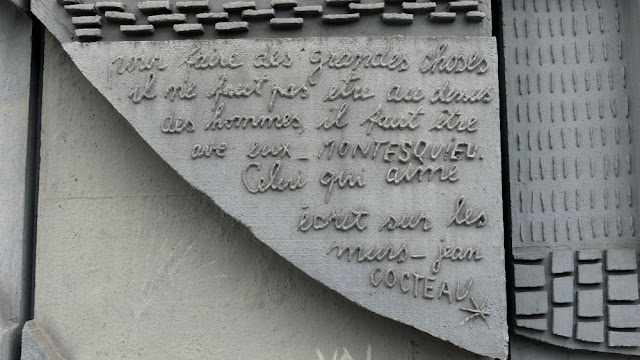Don’t you just love it when you finally spot a point of interest that you’ve been cycling/driving past for years without noticing? That was the case for me as regards the Le Médoc office building and its remarkable bas-relief mural, to be found on Rue Croix-de-Seguey near Barrière du Médoc.
I was tipped off when reading Marc Saboya’s fine “Chaban, le bâtisseur” which provides a detailed overview of former mayor Jacques Chaban-Delmas’s 50-year architectural and city planning legacy. University lecturer Saboya dedicates two pages to the building he refers to as “CILG”, cross-referencing back in time to its original purpose, which was to house the “Comité Interprofessionnel Logement Guyenne Gascogne".
He notes that the not-for-profit body was founded in 1949 to enable to working citizens to gain easier access to decent housing and, from 1951, from its base on Allées d’Orléans in central Bordeaux, oversaw the collection of compulsory taxes paid by corporations across the region to contribute to housing programmes for their employees, widely-known these days as the “1% patronal” or “1% logement” system.
The unusual Barrière de Médoc office block was therefore tailor-made for the CILG, built to the joint designs of architects Yves Salier, Adrien Courtois, Pierre Lajus, Michel Sadirac and erected between 1966 and 1968. It is unlike any other building in the vicinity: tall, angular, flat-roofed and comprising five rows of 18 curious rectangular alcoves encasing the office windows.
But the pièce de résistance is to be enjoyed at street level: the aforementioned bas-relief delivered by renowned painter-illustrator Véronique Filozof (or Filosof) in 1969.
 |
| Véronique Filozof in 1960, source: Wikipedia. |
She would go on to become well-known and loved for her black-and-white Indian ink sketches (invariably executed using a Sergent-Major quill pen), her colourful oil paintings and her impressive mural designs. Her work was regularly exhibited at a number of high-profile events, including a 1956 function where she joined the ranks of artists including Picasso, Miró and one Jean Cocteau, with whom she developed a strong creative bond and lasting friendship. She died in 1977 in her adopted hometown of Mulhouse in north-eastern France.
 |
| Examples of Filozof's artwork: "Le Palais royal, la marchande de légumes", source: veronique-filozof.fr. |
 |
| "Le Périgourdin", source: veronique-filozof.fr |
Other sections of the piece are more generic: trees, animals, a sea of faces, various abstract patterns, a majestic sun and a flower in bloom can all be spotted.
Completing the picture are a number of quotations, no doubt originally chosen to inspire CILG teams to go about their everyday business without losing sight of their raison d’être, to help people build better lives:
"Si tu veux aimer les pauvres, ne leur donne pas du pain, construisez ensemble une tour ou un navire" – Gabriel Rosset ("If you want to love the poor, do not give them bread, together build a tower or a ship.")
"Mais les yeux sont aveugles, il faut chercher avec le cœur" – Antoine de Saint Exupéry ("But eyes are blind. You have to look with the heart.”)
"Pour faire des grandes choses, il ne faut pas être au-dessus des hommes, il faut être avec eux" – Montesquieu ("To become truly great, one has to stand with people, not above them.")
"Celui qui aime écrit sur les murs" – Jean Cocteau ("He who loves writes on walls.")
"Argent, machinisme, algèbre, les trois monstres de notre civilisation." – Simone Weil ("Money, machines, algebra, the three monsters of our civilisation.")
"Penser c’est facile, agir c’est difficile, agir selon sa pensée est la chose la plus difficile du monde." – Johann Wolfgang von Goethe (“Thinking is easy, acting is difficult, and to put one's thoughts into action is the most difficult thing in the world.”)
"Tels les yeux des chauves-souris éblouis par l’éclat du jour, ainsi notre intelligence se trouve-t-elle éblouie par les choses les plus naturellement évidentes" – Aristote ("For as the eyes of bats are to the blaze of day, so is the reason in our soul to the things which are by nature most evident of all.")
And immediately below that quote is one final inscription: “Ce dessin est de Véronique Filosof 2.1969”.
Back to our office block though to finish off: the CILG vacated the building in 1977, moving to a new facility in the Lac district to the north of the city. Today’s Le Médoc building is home to a number of smaller companies and, while the exterior is in need of a little tender loving care (the “Le Médoc” sign could certainly do with a gentle overhaul!), the office block still seems to be in relatively good shape despite being on the verge of turning 50!
> A full website is dedicated to Véronique Filozof's work: www.veronique-filozof.fr
> “Chaban le bâtisseur" by Marc Saboya, published by Le Festin in partnership with La Mémoire de Bordeaux Métropole.
> Ce dossier est également disponible en français !
> “Chaban le bâtisseur" by Marc Saboya, published by Le Festin in partnership with La Mémoire de Bordeaux Métropole.
> Ce dossier est également disponible en français !



















0 commentaires: